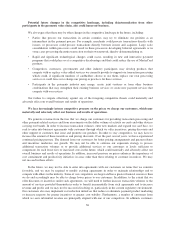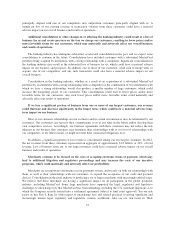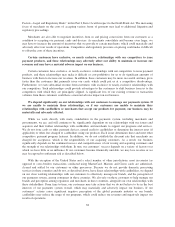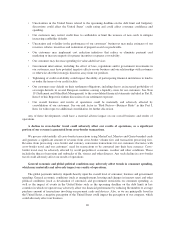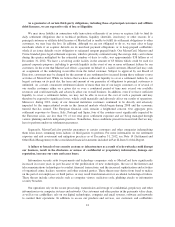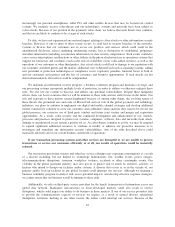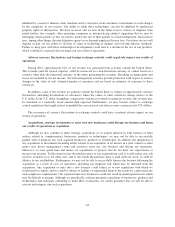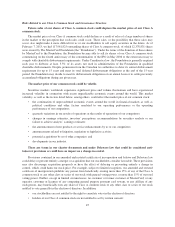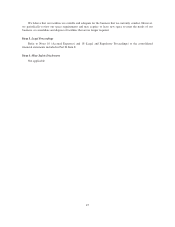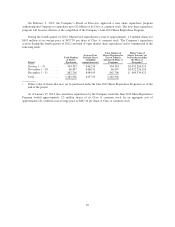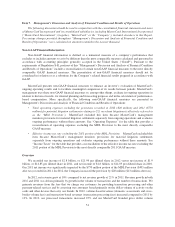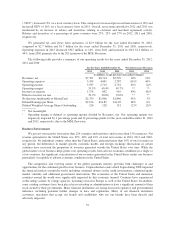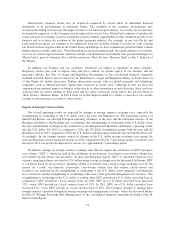MasterCard 2012 Annual Report Download - page 48
Download and view the complete annual report
Please find page 48 of the 2012 MasterCard annual report below. You can navigate through the pages in the report by either clicking on the pages listed below, or by using the keyword search tool below to find specific information within the annual report.inhibited by a need for industry-wide standards and by resistance from customers or merchants to such changes
by the complexity of our systems. Our ability to adopt these technologies can also be inhibited by intellectual
property rights of third parties. We have received, and we may in the future receive, notices or inquiries from
patent holders (for example, other operating companies or non-practicing entities) suggesting that we may be
infringing certain patents or that we need to license the use of their patents to avoid infringement. Such notices
may, among other things, threaten litigation against us or demand significant license fees. Our future success will
depend, in part, on our ability to develop or adapt to technological changes and evolving industry standards.
Failure to keep pace with these technological developments could lead to a decline in the use of our products,
which could have a material adverse impact on our results of operations.
Adverse currency fluctuations and foreign exchange controls could negatively impact our results of
operations.
During 2012, approximately 61% of our revenue was generated from activities outside the United States.
This revenue (and the related expense) could be transacted in a non-functional currency or valued based on a
currency other than the functional currency of the entity generating the revenues. Resulting exchange gains and
losses are included in our net income. Our risk management activities provide protection with respect to adverse
changes in the value of only a limited number of currencies and are based on estimates of exposures to these
currencies.
In addition, some of the revenue we generate outside the United States is subject to unpredictable currency
fluctuations (including devaluations of currencies) where the values of other currencies change relative to the
U.S. dollar. If the U.S. dollar strengthens compared to currencies in which we generate revenue, this revenue may
be translated at a materially lower amount than expected. Furthermore, we may become subject to exchange
control regulations that might restrict or prohibit the conversion of our other revenue currencies into U.S. dollars.
The occurrence of currency fluctuations or exchange controls could have a material adverse impact on our
results of operations.
Acquisitions, strategic investments or entry into new businesses could disrupt our business and harm
our results of operations or reputation.
Although we may continue to make strategic acquisitions of, or acquire interests in joint ventures or other
entities related to, complementary businesses, products or technologies, we may not be able to successfully
partner with or integrate any such acquired businesses, products or technologies. In addition, the integration of
any acquisition or investment (including efforts related to an acquisition of an interest in a joint venture or other
entity) may divert management’s time and resources from our core business and disrupt our operations.
Moreover, we may spend time and money on acquisitions or projects that do not meet our expectations or
increase our revenue. To the extent we pay the purchase price of any acquisition in cash, it would reduce our cash
reserves available to us for other uses, and to the extent the purchase price is paid with our stock, it could be
dilutive to our stockholders. Furthermore, we may not be able to successfully finance the business following the
acquisition as a result of costs of operations, including any litigation risk which may be inherited from the
acquisition. Any acquisition or entry into a new business could subject us to new regulations with which we
would need to comply, and we could be subject to liability or reputational harm to the extent we cannot meet any
such compliance requirements. Our expansion into new businesses could also result in unanticipated issues which
may be difficult to manage. Although we periodically evaluate potential acquisitions of businesses, products and
technologies and anticipate continuing to make these evaluations, we cannot guarantee that we will be able to
execute and integrate any such acquisitions.
44




